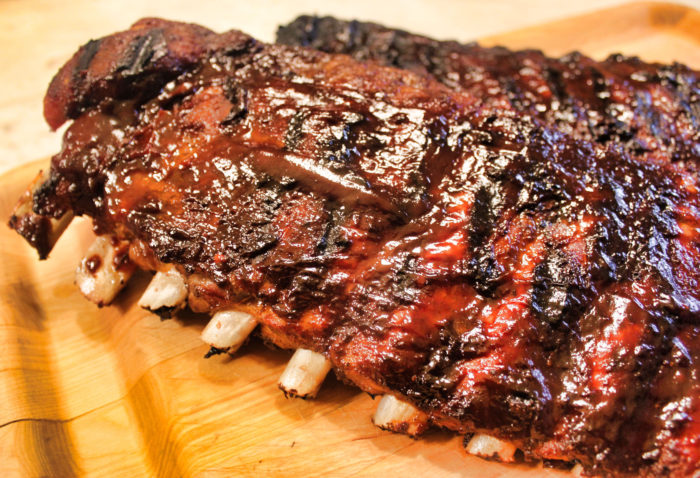
Here’s the scenario. It’s the weekend. Early afternoon. You’ve just returned from the store with some wonderful racks of St. Louis style spareribs. You want them for dinner and you search for a recipe.
And that’s when reality hits. There are lots of barbeque and meat books. Lots of rib recipes. And they all take time. Sometimes a full day of time. You’ll see suggestions to put the ribs in apple cider vinegar overnight or put on a rub and refrigerate, again for overnight. And the cooking methods are diverse, including that idea of boiling them to shorten the cooking time.
Suzi and I have poured though books and websites. Here’s our solution for you. You can have magnificent ribs in 5 hours and 10 minutes, no less, but no more. Oh, there’s just a little prep time probably, too.
Here’s what you need:
- One or more racks of St. Louis style ribs
- One or more cups of spice rub
- One or more bottles of prepared barbecue sauce.
Now, I say St. Louis style because they tend to have meat, lots of meat. Half the weight in that rack, or more, is bone, so what is left needs to be delicious. A rub? Yes, and you can find ideas all over the place in books and on the web. Just one thing: make your own. The pre-made rubs are filled with preservatives and they can upset your tummy.
Ah, lastly that sauce. I know, if you read this blog, you’ll think I am committing heresy here. Why would I not suggest making my own sauce. I would and I do. But just like you, sometimes, I need a break and I want the ease of just pouring something out of a nice bottle. The fact is evident: walk the aisles of your supermarket and you encounter those shelves with row upon row of barbecue sauce. A lot of them, a lot, are damn good. For example, Head Country from Oklahoma. In fact, you do want to look for products from Barbecue Land: Missouri, Tennessee, Texas, the Carolinas. The folks there know their meat and they make fine products.
Here’s what you do:
Take your ribs out of the packaging, wash them, dry them, and turn them meat side down. Is the bottom still covered with that silver skin? Yup? You need a sharp knife and some patience and a little time. Starting at the bone end of the ribs, pry up the skin and pull in away. There are good demoes for this on YouTube. Patience.
Now, that 5-hour clock begins. Coat both side of your ribs with the dry rub. Thoroughly coat so you see rub and no meat. The bone you can’t disguise. Depending on the dryness of the ribs and the absorption power of the meat, you’ll need at least a half cup of rub for each rack.
Cover the ribs in foil and refrigerate for 2 hours.
With a half hour of that 2-hour time to go, preheat your oven to 275° F.
Remove the ribs and place them into the oven. You do not need to let them come to room temperature first, because the oven is low, but you do need to make sure the ribs are completely sealed in foil. This cooking process uses natural steam as part of the chemistry.
In the meantime, preheat your grill to medium heat, about 300°. You could finish the ribs off under your oven broiler, but that often leads to burning and uneven cooking. You want flame because of all wonderful properties it bestows on meat. A medium heat here, not that usual barbecue high, because you want to finish the cooking process and not sin by drying the ribs out.
Cook the ribs for 2 hours. Remove the ribs from your oven. Take them to your grill and place them bone side down. Slather the meat with barbecue sauce. Do not be meager. Close the grill top and wait 30 minutes. Apply a second round of barbecue sauce. Cook for a second round of 30 minutes.
Remove from the grill. Allow to rest for 10 minutes. Have lots of paper towel on hand. As you can see from the picture, the operative words here are “sticky” and “gooey.” Oh, yes, and “perfect.” You could now pass a North Carolina barbecue hand!
Source: Suzi and Brian O’Rourke with assistance from lots of books and websites
Photo Information: Canon T2i, EFS 60mm Macro Lens, F/3.5 for 1/30th second at ISO‑800
